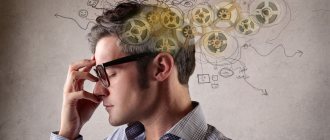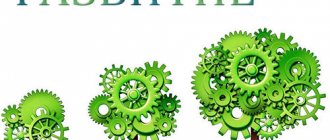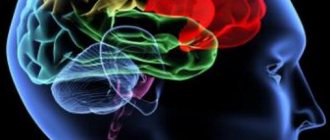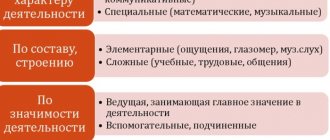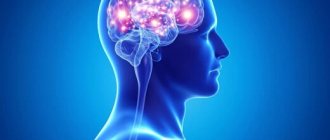Cognitive functions help us talk, plan, and learn about the world around us. Neurologist Anna Moroz talks about how they work and what interferes with them. She is one of the co-authors of the book “Medicine for Smart People.” Modern aspects of evidence-based medicine for thinking patients,” which was jointly written by 18 doctors.
With the permission of the Bombora publishing house, Lifehacker publishes an excerpt from the section on the brain.
I get the impression that many people consider cognitive function and memory to be almost synonymous. This is understandable, because interruptions in memory are very noticeable. Without memories, a person loses himself and ceases to exist as a person. And even the slightest forgetfulness of words or dates can be very alarming; it is too noticeable in everyday life.
In fact, there are a lot of cognitive functions, and they are not limited only to memory. Cognitive functions of the brain are a set of certain skills that ensure a person’s awareness. This is a person’s ability to receive and analyze information, store it in memory, recognize an object encountered earlier, draw conclusions, think in concepts, find similarities and differences, speak and accurately voice their ideas, make informed decisions, concentrate attention, find solutions to problems, make purposeful decisions. actions.
These complex functions are carried out primarily by the mysterious tertiary cortex. It integrates a variety of inputs from numerous areas of the primary and secondary cortex and only then produces something that makes most people so different from other animals - conscious action.
What does this concept mean?
Having high cognitive abilities means being able to use the information we receive from the environment. This includes all types of mental activity: memorization, processing, data analysis. These are mental processes during which all information received now or previously received is processed and becomes suitable for its further use in life.
In simple terms, cognitive ability is the ability to use your brain.
If a person has them at a high level, then he can fully use the brain: remember, draw conclusions, apply knowledge in everyday life, change his mind, etc.
Narrowness and breadth
This implies the narrowness and breadth of the range of equivalence. Such cognitive styles characterize individual characteristics on the scale used by a person when evaluating the differences and similarities of objects.
Some people, when randomly classifying, can divide objects into many groups with a small volume of objects (this is a narrow range), while others - into a smaller number of groups with a large volume of objects (this is a wide range).
The basis of these differences is mainly the level of “sensitivity” to established differences and the focus on establishing differences of different types. A person with a narrow range of equivalence relies on the physical properties of objects, and a person with a wide range relies on hidden additional properties. Some domestic experts characterize the first style as analytical, and the second as synthetic. A connection has also been established between analytical and synthetic cognitive styles with personality characteristics.
Types of cognitive abilities
This group includes the following skills:
- Attention and concentration - the ability to focus on a specific activity without being distracted by external factors.
- Gnosis, or perception, is the ability to receive information from the outside.
- Memory – remembering, storing and recalling data at the right time.
- Praxis, or action, is the ability to apply knowledge, and not just memorize theory.
- Thinking, or logic - processing information, creating your own conclusions, generalization, comparison and other processes.
- Imagination is the ability to imagine, fantasize, dream, that is, to build your own images.
- Decision making is choosing the right option from several alternatives.
Now let's imagine a person who has developed all these skills. He easily remembers a large amount of information or filters out what does not need to be remembered. He knows how to concentrate, does not lose the thread of a conversation, and always understands the meaning of the text he has just read, because he is not distracted. Draws conclusions independently and has creative abilities.
All these skills are interconnected. And if you know how to develop them, any person will become like that. If you develop concentration, your memory will improve. And if you remember a lot of information, you will be able to make better conclusions and choices. Special methods will also help you with this; I wrote about them in an article on how to make decisions.
Cognitive abilities and psychology
Each client, turning to a psychotherapist, receives a personal plan for working on himself. One of the areas widely used to solve a variety of problems is cognitive behavioral therapy.
Practitioners who use the tools of this direction argue that the cause of any problem lies in human thinking.
The psychologist tries to study the client, to identify his attitudes that are “hardwired” into memory and force him to act in a certain way. Then the specialist shows this attitude to the person and teaches him to think more effectively, that is, helps him change his thinking.
This clearly shows how closely related cognitive abilities are. First, a person receives a certain experience (in childhood or in adulthood). His brain processes this information and makes a certain conclusion - an attitude. In the future, the person makes decisions in accordance with the summed up results. If the conclusion is made incorrectly, and an attitude is formed that interferes with life, the person suffers from psychological problems.
The methods I will discuss below will help you avoid falling into this trap.
Rigidity and flexibility
These cognitive styles are related to how easy or difficult it is for a person to change activities and switch from one information base to another. If it is difficult for a person to switch, then his cognitive control will be inflexible and narrow.
The concept of “rigidity” was introduced by psychologist R. Cattell in 1935 to denote the constant repetition of the same movements, images and thoughts while switching from one form of activity to another.
Cattell identified significant differences in how this phenomenon manifests itself in practice. And you can determine whether a person belongs to a rigid or flexible cognitive style using the Stroop verbal-color test, when the test taker needs to name the colors in which words are written, these colors denote, but the color in which the word is written and the color that it denotes are different. from friend.
How does the brain develop?
Cognitive functions are formed in the first days of our life, when the brain begins to receive information about the outside world. The development of cognitive abilities in a child occurs in 3 stages.
- Visually effective (from 0 to 3 years). Children learn perception: to distinguish tastes, smells, appearance. They study the functions of dad and mom, as well as their characters. This is why children behave differently with their parents: for example, they are capricious with their mother, but obedient with their father.
- Visual-figurative (from 3 to 7 years). At this age, logical thinking develops. The child has already learned to perform simple tasks and begins to actively train his memory and imagination. This becomes the reason for children's inventions and untrue stories. This does not mean that the child is lying, but only indicates the growth of his cognitive abilities.
- Distracted (from 7 years old). The child learns to imagine and understand abstract concepts, that is, he tries to come up with something of his own based on the information received over the years.
To help children develop their cognitive abilities, it is necessary to give them daily attention, take them to various clubs, and teach them how to make decisions by example. In the future, the person will improve his skills independently.
Reflexivity and impulsiveness
These cognitive styles were identified in 1976 by another psychologist, N. Kogan, in the process of studying human intellectual activity in decision-making situations, which are characterized by conditions of uncertainty, and where several alternatives need to be considered in order to make a choice.
An impulsive person always reacts quickly to problematic situations, and also finds and accepts solutions without careful evaluation. A reflective person, on the contrary, reacts somewhat slowly, and makes decisions only after a thorough assessment and consideration of all the pros and cons. In addition, reflective people tend to use more effective ways to solve problems and more successfully implement mastered activity strategies in relation to new situations.
How to develop cognitive functions
The abilities of our brain directly depend on our state of health. If the body has enough vitamins and good blood circulation, then you can count on proper brain function and the rapid formation of neural connections. Therefore, among the recommendations you will find not only specific mental exercises, but also lifestyle tips.
Create a complete diet
This does not mean that you need to deprive yourself of your favorite “harmful foods” forever. Most of the time, it is enough to ensure that your food contains the necessary minerals and vitamins. Also, be sure to stay hydrated - dehydration negatively affects brain function and cognitive function decreases.
To improve your mental abilities, add fats to your diet: nuts, oils, red fish. Also, do not forget about carbohydrates, which we need for energy, and proteins, without which organs cannot function normally.
sleep well
Lack of sleep primarily affects our brain. I think everyone has noticed the difference in well-being if they sleep 8 hours versus 3. The following recommendations will help improve attention, concentration and memory:
- sleep at least 7 hours a day;
- fall asleep before 22:00;
- 2 hours before bedtime, exclude emotional events;
- spend the night in a well-ventilated room.
It is also not recommended to watch movies, videos on your phone, or play computer games before going to bed. But since it is very difficult to adhere to this rule (I also like to spend time on my phone before going to bed), try to at least minimize irritating factors.
Eliminate bad habits
Stop smoking and alcohol first if you want your brain to function well into old age. Neurons that support all cognitive functions die due to the influence of alcohol, tobacco and psychotropic substances.
You can have a glass of wine at dinner with a friend or enjoy hookah once a month, but this should not become your regular pastime.
Reduce stress
“Easy to say!” – you will be indignant, and I will understand you. But you need to deal with stress. All cognitive functions suffer from it.
During a stressful situation, the amygdala of the brain (in scientific language - amygdala) is activated. It turns off our ability to think rationally, logically and blocks parts responsible for cognitive functions. The body works in “fight or flight” mode, when its only task is to hide from danger.
This applies not only to serious shocks, but also to such “little things” as nervous work, quarrels with your husband and worries about lack of money.
The harmful effects of stress can be reduced through regular meditation and other anxiety-reducing practices.
Organize an information detox
Our brain perceives information constantly throughout the day. Everything we hear, see and feel is recorded by neurons. If we load our heads with a large amount of unnecessary data, then the brain will have to “free up” space for them due to a decrease in cognitive functions.
How to improve brain function:
- don't watch TV;
- limit viewing of entertainment programs;
- reduce the time spent monitoring bloggers;
- try every day to be alone with yourself, without talking to anyone.
Your brain remembers information about what a girl you didn’t know on Instagram ate for breakfast or what happened to a person who had an accident in another part of the city. Instead, it is better to load it with useful data, depending on your interests. For example, a new recipe or knitting pattern.
I recommend regularly having a day when you don't use the Internet. For me this is once every 2 weeks. Take this time for yourself and do what you love.
Look for brain-healthy stimuli
The “detox” has been arranged, now you need to load your head with useful information. Here are some good ideas:
- go to a concert;
- visit an art gallery;
- visit nature;
- visit a restaurant and try a new dish;
- read a book;
- study a scientific experiment;
- go to the cinema to watch a quality film.
It is important that incentives are of high quality. If the book is a classic, history or self-development. If the film is a documentary or about a famous person who has achieved success.
Play sports and relax actively
Fast walking is also a sport. Therefore, there is no need to buy an expensive gym membership. You can ride a bike, swim, jump rope. This is necessary, especially for people with sedentary work.
If you are too lazy to exercise, I recommend our article on how to motivate yourself to exercise.
Some interesting exercises
They help develop high cognitive abilities in children and adults who have been stuck in place.
- Crossing movements. Lie on your back on a flat surface. Bend your left leg at the knee, your right arm at the elbow and bring them together. Then repeat the action with your right leg and left arm. Movements should be slow. This stimulates brain activity.
- Exercise "Elephant". It is carried out standing. Tilt your head towards your right shoulder. Extend your right hand forward and try to draw an infinity sign with it. Do it alternately for both sides. It helps improve the body-brain connection and is good for children as they learn to read and write.
- Synchronized drawing. Take pencils in both hands. Place a blank sheet of paper on the table. Try to draw symmetrical shapes with both hands at the same time. Improves coordination, stimulates the left and right hemispheres of the brain.
Dancing is also recommended. Try it at home while listening to your favorite song – it’s a great stress reliever and improves your mood. Or join a dance studio near you to learn new moves and improve your memory.
Cognitive personality traits.
Cognitive style
is a term used in cognitive psychology to refer to enduring characteristics of how different people think, perceive, and remember information, or their preferred way of solving problems.
Cognitive style is usually distinguished from cognitive ability
or
level
- the latter is measured by so-called intelligence tests. There is still disagreement about the meaning of the term “cognitive style.” However, the term "cognitive style" is widely used, especially in applied business psychology, as well as in educational psychology, where it has a synonym - "learning style").
The concept of cognitive style was first used by A. Adler to denote a personality characteristic, which represents stable individual characteristics of cognitive processes that predetermine the use of various research strategies. Within the framework of his individual psychology, it was understood as the uniqueness of a person’s life path, structured by setting and achieving goals.
G. Allport began to consider cognitive style as an integral personality system of an instrumental order (ways and means to achieve goals). Subsequently, this problem was dealt with by K. Stadner, G. Witkin and others.
In the former USSR, the study of cognitive styles was carried out by V. A. Kolga (Estonia), the Teplov-Nebylitsyn school (Moscow), M. A. Kholodnaya (Kyiv, since the 1990s - Moscow), A. Libin, and others.
A similar concept is metaprograms in NLP. Some of the cognitive styles listed below are at least correlated with the metaprograms described in the literature[1].
Essence
The nature of cognitive styles is not fully understood. There is evidence of their connection with interhemispheric asymmetry, level of intelligence, temperament properties and personal motivation[2]. At the same time, there is every reason to consider cognitive styles to be an education that is formed during life under the influence of sociocultural factors[3]. For example, it has been empirically proven that field dependence is more typical for women, as well as for children whose parents exercise excessive control over their behavior [2] [3].
Varieties of cognitive styles
Most often, about 10-15 cognitive styles are considered in the literature (it is noted that many of them obviously correlate with each other, and the difference in terminology is due to the approaches of different authors):
· field independence - field dependence;
Representatives of the field-dependent style trust visual impressions more when assessing what is happening and have difficulty overcoming the visible field when it is necessary to detail and structure the situation. Representatives of the field-independent style, on the contrary, rely on internal experience and easily tune out the influence of the field, quickly and accurately identifying a detail from a holistic spatial situation.
· concreteness - abstractness;
Concreteness-abstractness is based on psychological processes such as differentiation and integration of concepts. The pole of “concrete conceptualization” is characterized by insignificant differentiation and insufficient integration of concepts. The following psychological qualities are typical for “concrete” individuals: a tendency to black-and-white thinking, dependence on status and authority, intolerance of uncertainty, stereotypical decisions, situational nature of behavior, less ability to think in terms of hypothetical situations, etc. On the contrary, the pole “ abstract conceptualization" implies both high differentiation and high integration of concepts. Accordingly, “abstract” individuals are characterized by freedom from the immediate properties of the situation, an orientation towards internal experience in explaining the physical and social world, a tendency to take risks, independence, flexibility, creativity, etc.
· smoothing - sharpening;
Individual differences recorded in this cognitive style are related to the characteristics of storing memorized material in memory. With “smoothers”, storing material in memory is accompanied by its simplification, loss of details, and the loss of certain fragments. On the contrary, in the memory of “sharpeners”, specific details of the memorized material are highlighted and emphasized. Subsequently, it was specially emphasized that this style parameter reveals itself in conditions of perception and memorization of a sequence of stimuli, thus characterizing the sensitivity of subjects to gradually increasing differences in a number of perceived influences.
· rigid—flexible cognitive control;
This cognitive style characterizes the degree of subjective difficulty in changing methods of processing information in a situation of cognitive conflict. Rigid control indicates difficulties in the transition from verbal to sensory-perceptual functions due to their low degree of automation, while flexible control indicates the relative ease of such a transition due to their high degree of automation.
· low - high tolerance to unrealistic experience;
This cognitive style reveals itself in uncertain, ambiguous situations and characterizes the degree of acceptance of impressions that do not correspond or even contradict the person’s ideas, which he regards as correct and obvious. Tolerant subjects evaluate experiences according to their actual characteristics, while intolerant subjects resist cognitive experiences in which the initial data contradicts their existing knowledge.
· focusing - scanning control
;
This cognitive style characterizes individual characteristics of the distribution of attention, which are manifested in the degree of breadth of coverage of various aspects of the displayed situation, as well as in the degree of consideration of its relevant and irrelevant features. Accordingly, some subjects quickly distribute attention to many aspects of the situation, while highlighting its objective details (the pole of broad, or scanning, control). The attention of other subjects, on the contrary, turns out to be superficial and fragmented, while it captures obvious, conspicuous characteristics of the situation (the pole of narrow, or focusing, control).
· impulsiveness - reflectivity;
People with an impulsive style quickly make hypotheses in a situation of alternative choice, while they make many erroneous decisions in identifying perceptual objects. People with a reflective style, on the contrary, are characterized by a slower pace of decision-making in such a situation; accordingly, they make few mistakes when identifying perceptual objects due to their thorough preliminary analysis.
· narrow—wide range of equivalence;
Representatives of the pole of a narrow range of equivalence (analytical style) tend to focus on the differences between objects, paying attention mainly to their details and distinctive features. Representatives of the pole of a wide range of equivalence (synthetic style), on the contrary, tend to focus on the similarity of objects, classifying them taking into account some generalized categorical bases.
· cognitive simplicity - complexity;
Some people understand and interpret what is happening in a simplified form based on recording a limited set of information (the pole of cognitive simplicity). Others, on the contrary, tend to create a multidimensional model of reality, highlighting many interconnected aspects in it (the pole of cognitive complexity).
Cognitive style, like other stylistic formations of an individual, performs the following functions: 3 1. adaptive, consisting in adapting the individual to the requirements of a given activity and social environment; 2. compensatory, since its formation is based on the strengths of the individual and taking into account the weaknesses; 3.system-forming, which allows, on the one hand, to form a style based on many previously established characteristics of individuality, and, on the other hand, to influence many aspects of human behavior; 4. self-expression, consisting in the ability of an individual to express himself through a unique way of performing an activity or through a manner of behavior
https://ru.wikipedia.org/wiki/Cognitive_style
“Cognitive” – related to the mental mechanisms of information processing in the process of constructing a cognitive image at different levels of cognitive reflection, i.e. This term is addressed to how a cognitive image is constructed. We are talking about individual differences in the ways of processing information in one’s environment, or cognitive styles themselves as a certain type of cognitive styles, which should be understood as individually unique ways of studying reality. Cognitive styles are a formal-dynamic characteristic of intellectual activity, not related to the content (effective) aspects of the work of the intellect. In addition, cognitive styles are stable cognitive preferences characteristic of a given individual, manifested in the predominant use of certain methods of processing information - those methods that best correspond to the psychological capabilities and inclinations of a given person. Thus, the term “cognitive style,” being a characteristic of the cognitive sphere, reflects the characteristics of personal orientation as a whole.
Each cognitive style was considered by scientists as a psychological trait of a higher order, including not only cognitive, but also motivational, emotional and other personal characteristics. Moreover, some authors consider cognitive styles as personality traits.
Recommended pages:
Use the site search:


